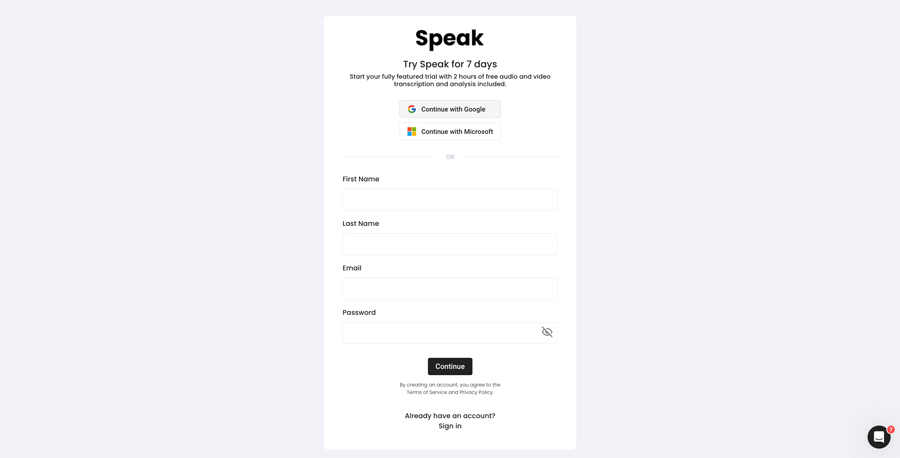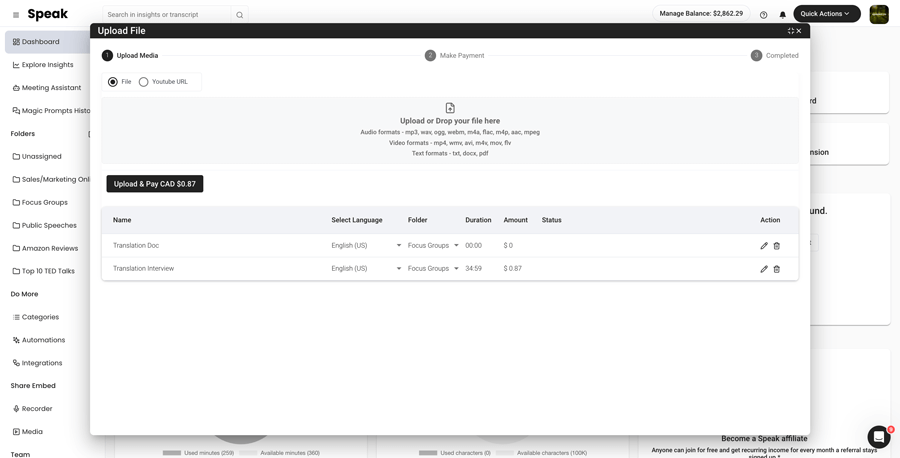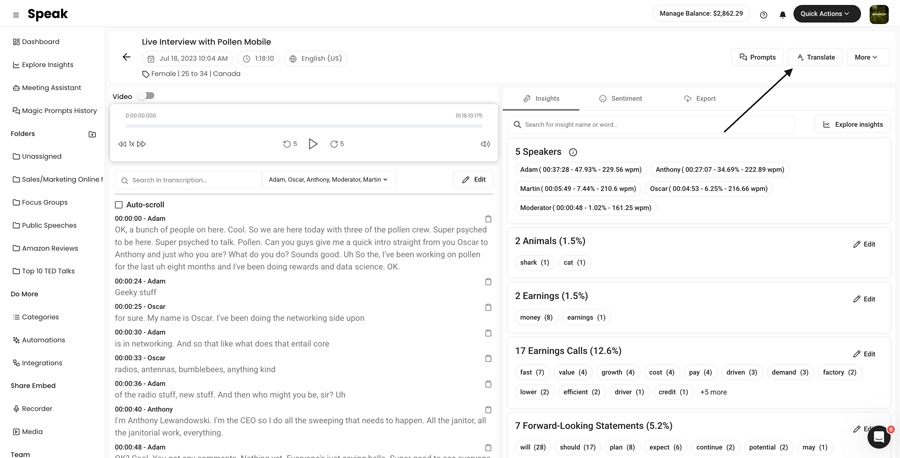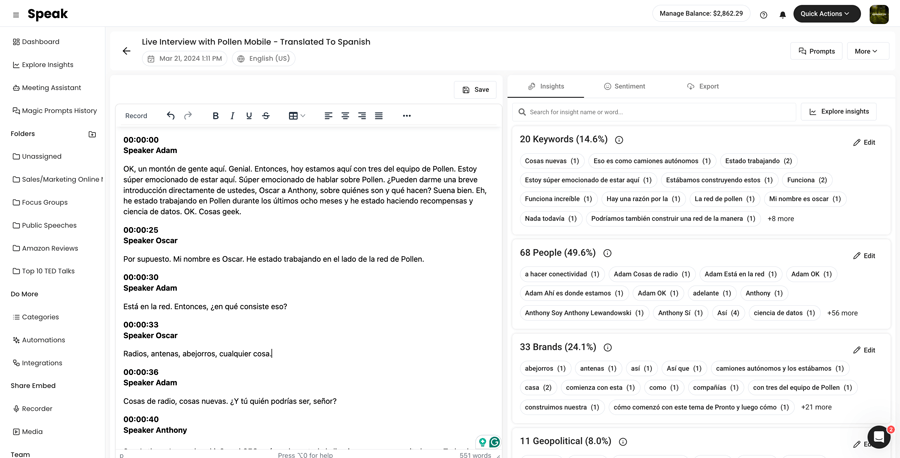How To Translate Latin to Korean
Translating Latin to Korean is super simple!

Step 1: Register for Speak
Register for Speak using this link.
Once you register, you can instantly begin translating your Latin to Korean file(s).

Step 2: Upload Your Latin file(s)
As soon as you log in, you will be redirected to the dashboard.
Once there, you can select the Quick Action "New Upload".
In Speak, you can seamlessly upload, transcribe and translate audio, video and text files all at once!

Step 3: Translate Your Latin file(s) to Korean
Once the file is uploaded, simply visit your file and select "Translate".
If it is an audio and video file, Speak will ask you if you want to keep the speaker names and timestamps in the translation.
Want to translate many files at once? No problem!
You can view the files you want to automatically translate from Latin to Korean from the folder level and instantly translate as many files as you need with our artificial intelligence translation in just a few clicks.

Step 4: That's It! View, Analyze, Modify & Export Your New Korean file(s)
Once the translation is done, you will be alerted and you will see a new document in the same folder your original file is in.
The file will be named the same but with a dash indicating that it is the translated version.
Need support with your Latin translation?
We are always here and happy to help at Speak!
Just send us a message on live chat on the bottom right corner and we will ensure you are set up for success.
Interested in translating Latin or other languages to different languages? View our entire list of supported translation languages here.
Automatic, accurate, instant AI translation from Latin to Korean is here for you.
Register for Speak using this link and begin translating Latin to Korean today.
Unlocking New Horizons: Translate Latin to Korean with AI Technology
As the world grows increasingly interconnected, the ability to communicate across linguistic boundaries becomes more crucial. Bridging the gap between ancient and modern, the translation from Latin to Korean represents not just a linguistic challenge but a doorway to historical wisdom, cultural exchange, and commercial opportunities. Speak AI, leveraging NLP and transcription software, is at the forefront of this transformative journey. Let's dive into how translating Latin to Korean can bring unparalleled value to researchers, businesses, and language enthusiasts.
The Power of AI in Translation
In the digital age, AI translation has revolutionized how we interact with different languages. Speak AI's integration of NLP, large language models, data visualization, and Generative AI has made translations more accurate, efficient, and accessible than ever before. Whether it's audio, video, or text, our AI Meeting Assistant seamlessly transcribes and translates content, ensuring that language is no longer a barrier to knowledge and business expansion.
Benefits of Translating Latin to Korean
Translating Latin to Korean is not just about converting words; it's about connecting worlds. Here are some benefits of utilizing AI for these translations:
- Access to Historical Documents: Researchers can explore Latin texts, uncovering historical, philosophical, and scientific knowledge without the barrier of language.
- Global Business Expansion: Businesses can tap into Korean markets by translating legal, technical, and marketing materials from Latin or vice versa, ensuring accurate and culturally relevant content.
- Cultural Exchange: Translating literary works and historical texts enriches cultural understanding, showcasing the depth and diversity of human civilizations.
Time and Cost Efficiency
AI-driven translations significantly reduce the time and cost associated with traditional translation methods. Automatic translation processes audio, video, and text in a fraction of the time it would take human translators, without compromising on accuracy. This expedience and efficiency are invaluable for high-stakes research and fast-paced business environments looking to make informed decisions quickly.
Latin and Korean on the World Stage
Geographical and Linguistic Impact
Latin, the lingua franca of the Roman Empire, has influenced numerous languages and remains a critical subject of study in education, law, and the sciences. Korean, spoken by over 75 million people worldwide, serves as a bridge to one of Asia's most dynamic economies and rich cultural landscapes. Translating between these languages opens a channel for scholarly exploration and economic partnerships.
Interesting Stats: Nations and Speakers
While Latin is no longer spoken as a native language, its legacy endures in modern Romance languages and in various academic, legal, and ecclesiastical contexts. Korean, predominantly used in South Korea and North Korea, is also spoken by significant diaspora communities across the United States, China, Japan, and Russia.
Historic and Cultural Significance
Latin's historical depth and Korean's cultural vibrancy offer unique insights and opportunities for those interested in humanities, social sciences, and international business.
Exploring Latin and Korean: Fun Facts and Language Dynamics
A Fusion of Ancient and Modern
- Latin is the ancestor of the Romance languages and has contributed numerous words to the English language, science, and law.
- Korean is known for its unique Hangul alphabet, created in the 15th century, praised for its scientific design and inclusivity in literacy.
Similarities and Differences
Despite their distinct origins, Latin and Korean share linguistic features such as the importance of formal and informal speech levels, reflecting social hierarchies and relationships. Conversely, their syntax, grammar, and writing systems highlight the diversity of human language, offering fascinating areas of study for linguists and translators alike.
Conclusion: Bridging Worlds with Speak AI
Translating Latin to Korean embodies the confluence of history, culture, and technology. Speak AI's advanced NLP and transcription services not only facilitate this linguistic journey but also ensure it's accurate, efficient, and impactful. Whether you're a researcher deciphering ancient texts, a business venturing into new markets, or a language enthusiast exploring the richness of human expression, Speak AI is your partner in transcending linguistic boundaries. Embrace the future of translation, and let's unlock new horizons together.
Ready to Explore Further?
Discover how Speak AI can transform your linguistic endeavors. With a 4.9 rating on G2 and over 150K satisfied users, our technology is primed to advance your translation needs from Latin to Korean and beyond. Join us in making language accessible to all, bridging historical wisdom and modern innovation for a truly global community.
---
Now, let's address the subsequent inquiries about the locations of Latin and Korean popularity, interesting stats, and the linguistic dynamics between these two languages:
Locations of Latin and Korean Popularity
- **Latin**: While Latin is primarily a scholarly language today, its influence spans across Europe, deeply rooted in the education systems of many Western countries. It’s also significant in the Vatican City, where it remains an official language.
- **Korean**: Korean is predominantly spoken in South Korea and North Korea, with significant speaker populations in China, the United States, Japan, and Russia, catering to a global diaspora.
Interesting Stats and History
- Latin, though not spoken conversationally, continues to be the foundation of Romaic as well as legal, scientific, and theological terminology globally.
- Korean boasts over 75 million speakers worldwide, making it one of the most spoken languages.
Fun Facts about Latin and Korean
- Latin laid the groundwork for the Romance languages and has enriched the English vocabulary with myriad loanwords.
- The Korean alphabet, Hangul, was developed under King Sejong the Great and is celebrated for its simplicity and scientific approach to phonetics.
Differences and Similarities Between Latin and Korean
- **Similarities**: Both languages have influenced their respective cultures profoundly, with formal speech levels playing essential roles in their social structures.
- **Differences**: Latin's impact is more historical and scholarly, while Korean's influence is vibrant and expansive in contemporary society. Their grammatical structures, vocabulary, and usage in communication vastly differ, denoting the rich diversity of human language development.
Translate Latin To These Other Supported Languages:
- Translate Latin-to-Afrikaans
- Translate Latin-to-Albanian
- Translate Latin-to-Amharic
- Translate Latin-to-Arabic (Egypt)
- Translate Latin-to-Arabic (Iraq)
- Translate Latin-to-Arabic (Israel)
- Translate Latin-to-Arabic (Jordan)
- Translate Latin-to-Arabic (Kuwait)
- Translate Latin-to-Arabic (Lebanon)
- Translate Latin-to-Arabic (Oman)
- Translate Latin-to-Arabic (Palestinian Authority)
- Translate Latin-to-Arabic (Qatar)
- Translate Latin-to-Arabic (Saudi Arabia)
- Translate Latin-to-Arabic (Syrian Arab Republic)
- Translate Latin-to-Arabic (United Arab Emirates)
- Translate Latin-to-Arabic Modern Standard (Bahrain)
- Translate Latin-to-Armenian
- Translate Latin-to-Assamese
- Translate Latin-to-Aymara
- Translate Latin-to-Azerbaijani
- Translate Latin-to-Bambara
- Translate Latin-to-Basque
- Translate Latin-to-Belarusian
- Translate Latin-to-Bengali
- Translate Latin-to-Bhojpuri
- Translate Latin-to-Bosnian
- Translate Latin-to-Bulgarian
- Translate Latin-to-Catalan
- Translate Latin-to-Cebuano
- Translate Latin-to-Chinese (Simplified)
- Translate Latin-to-Chinese (Traditional)
- Translate Latin-to-Corsican
- Translate Latin-to-Croatian
- Translate Latin-to-Czech
- Translate Latin-to-Danish
- Translate Latin-to-Dari
- Translate Latin-to-Dhivehi
- Translate Latin-to-Dogri
- Translate Latin-to-Dutch
- Translate Latin-to-English
- Translate Latin-to-English (Australia)
- Translate Latin-to-English (Indian)
- Translate Latin-to-English (Irish)
- Translate Latin-to-English (New Zealand)
- Translate Latin-to-English (Scottish)
- Translate Latin-to-English (South African)
- Translate Latin-to-English (United Kingdom)
- Translate Latin-to-English (United States)
- Translate Latin-to-Esperanto
- Translate Latin-to-Estonian
- Translate Latin-to-Ewe
- Translate Latin-to-Farsi (Persian)
- Translate Latin-to-Filipino Tagalog
- Translate Latin-to-Finnish
- Translate Latin-to-French
- Translate Latin-to-French (Canada)
- Translate Latin-to-Frisian
- Translate Latin-to-Galician
- Translate Latin-to-Georgian
- Translate Latin-to-German
- Translate Latin-to-German (Swiss)
- Translate Latin-to-Greek
- Translate Latin-to-Guarani
- Translate Latin-to-Gujarati
- Translate Latin-to-Haitian Creole
- Translate Latin-to-Hausa
- Translate Latin-to-Hawaiian
- Translate Latin-to-Hebrew
- Translate Latin-to-Hindi
- Translate Latin-to-Hmong
- Translate Latin-to-Hungarian
- Translate Latin-to-Icelandic
- Translate Latin-to-Igbo
- Translate Latin-to-Ilocano
- Translate Latin-to-Indonesian
- Translate Latin-to-Irish
- Translate Latin-to-Italian
- Translate Latin-to-Japanese
- Translate Latin-to-Javanese
- Translate Latin-to-Kannada
- Translate Latin-to-Kazakh
- Translate Latin-to-Khmer
- Translate Latin-to-Kinyarwanda
- Translate Latin-to-Konkani
- Translate Latin-to-Korean
- Translate Latin-to-Krio
- Translate Latin-to-Kurdish
- Translate Latin-to-Kurdish (Sorani)
- Translate Latin-to-Kyrgyz
- Translate Latin-to-Lao
- Translate Latin-to-Latin
- Translate Latin-to-Latvian
- Translate Latin-to-Lingala
- Translate Latin-to-Lithuanian
- Translate Latin-to-Luganda
- Translate Latin-to-Luxembourgish
- Translate Latin-to-Macedonian
- Translate Latin-to-Maithili
- Translate Latin-to-Malagasy
- Translate Latin-to-Malay
- Translate Latin-to-Malayalam
- Translate Latin-to-Maltese
- Translate Latin-to-Maori
- Translate Latin-to-Marathi
- Translate Latin-to-Meiteilon (Manipuri)
- Translate Latin-to-Mizo
- Translate Latin-to-Mongolian
- Translate Latin-to-Myanmar (Burmese)
- Translate Latin-to-Nepali
- Translate Latin-to-Norwegian
- Translate Latin-to-Nyanja (Chichewa)
- Translate Latin-to-Odia (Oriya)
- Translate Latin-to-Oromo
- Translate Latin-to-Pashto
- Translate Latin-to-Persian
- Translate Latin-to-Polish
- Translate Latin-to-Portuguese
- Translate Latin-to-Portuguese (Brazilian)
- Translate Latin-to-Portuguese (Portugal)
- Translate Latin-to-Punjabi
- Translate Latin-to-Quechua
- Translate Latin-to-Romanian
- Translate Latin-to-Russian
- Translate Latin-to-Samoan
- Translate Latin-to-Sanskrit
- Translate Latin-to-Scots Gaelic
- Translate Latin-to-Sepedi
- Translate Latin-to-Serbian
- Translate Latin-to-Sesotho
- Translate Latin-to-Shona
- Translate Latin-to-Sindhi
- Translate Latin-to-Sinhala
- Translate Latin-to-Sinhala (Sinhalese)
- Translate Latin-to-Slovak
- Translate Latin-to-Slovenian
- Translate Latin-to-Somali
- Translate Latin-to-Spanish
- Translate Latin-to-Spanish (Mexico)
- Translate Latin-to-Sundanese
- Translate Latin-to-Swahili
- Translate Latin-to-Swedish
- Translate Latin-to-Tajik
- Translate Latin-to-Tamil
- Translate Latin-to-Tatar
- Translate Latin-to-Telugu
- Translate Latin-to-Thai
- Translate Latin-to-Tigrinya
- Translate Latin-to-Tsonga
- Translate Latin-to-Turkish
- Translate Latin-to-Turkmen
- Translate Latin-to-Twi (Akan)
- Translate Latin-to-Ukrainian
- Translate Latin-to-Urdu
- Translate Latin-to-Uyghur
- Translate Latin-to-Uzbek
- Translate Latin-to-Vietnamese
- Translate Latin-to-Welsh
- Translate Latin-to-Xhosa
- Translate Latin-to-Yiddish
- Translate Latin-to-Yoruba
- Translate Latin-to-Zulu



